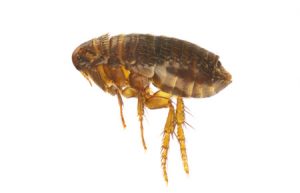

Flea Control
Fleas Overview

The cat flea is the most common pest flea that we encounter on cats, dogs, and wildlife. Even homes without pets can have loafing wildlife which can cause problems requiring flea control indoors.
These pests are parasitic in nature and feed on blood, which they suck from their preferred host. They have powerful legs that allow them to jump 100 times their own height and a compressed body shape that allows them to easily crawl through the fur of their host, making our flea removal methods crucial in early stages.
Fleas undergo a full metamorphosis. Eggs are laid on a host, but easily fall off onto carpets, furniture, cracks and crevices where they hatch into worm-like larvae and then develop into immobile pupae. The pupal stage, which is akin to the cocoon of a butterfly, can remain dormant for weeks or months when no hosts are around to ensure its survival. However, when the pupa is stimulated by a vibration or change in temperature that indicates a potential host is near, the adult flea emerges from its dormancy and immediately jumps to obtain a blood meal. So, vacating a home for some time to “starve out” the fleas rarely works—they just patiently wait for your return.
Where are They Found?

Due to their parasitic nature, adult fleas are most likely to be found on your pet. But they can also be found on pet beds or carpeting if there is an infestation in your home. If you think you have fleas, you can try the white sock test: put on a pair of high white socks and walk around, getting your feet on furniture and carpeting. If there are fleas in your home, you’ll likely see some of them on your socks.
What Makes Fleas Harmful?

Fleas can give your pet tapeworms when they accidentally ingest fleas while biting and grooming themselves. Besides the obvious discomfort if it has fleas, your pet may scratch excessively, causing the skin to become raw, which can pave the way for various diseases and infections. Fleas have the capability to transmit various diseases from one pet to another or to humans.
Signs Fleas are Present in Your Home or Facility

The easiest way to tell if you have a flea infestation in your home is seeing if your pet has fleas. Fleas were fairly prevalent in homes just a few decades ago. With the advent of excellent systemic flea products such as Frontline®, their numbers had diminished—only to rebound in recent years, due in part to complacency on the part of pet owners.
Because humans are not a preferred host for fleas, it may take weeks before you detect an infestation. Inspect your pet’s coat for signs of fleas—we recommend that you use a special flea comb. If you see tiny black specs (called flea dirt, but actually flea feces) on the comb, you have an infestation. If you don’t take flea extermination measures at this stage, it will only get worse.
Treatment

The first step in flea control is to arrange treatment for your pet, which should be handled by a professional.
We then ask that you thoroughly vacuum rugs, bedding and upholstery. Pay close attention to places where your pet spends the most time, such as windowsills, pet beds and favorite pieces of furniture. Then discard the vacuum cleaner bag so you do not re-infest your home with fleas escaping the vacuum.
Through our flea removal service, Braman will then treat your home with residual sprays and insect growth regulators. Because the insecticides have no impact on the pupal stage, we ask that you continue to aggressively vacuum after flea control treatment to remove as many life stages as possible and to stimulate the pupae into emerging and coming into contact with our treatments.
As with all treatments that Braman performs, our flea pest control service comes with a guarantee of your satisfaction. If you think you have an infestation of fleas, contact our experts immediately.

Tell us about your pest problem. We can provide a free estimate over the phone.
Call Braman 24/7 at 800-338-6757

